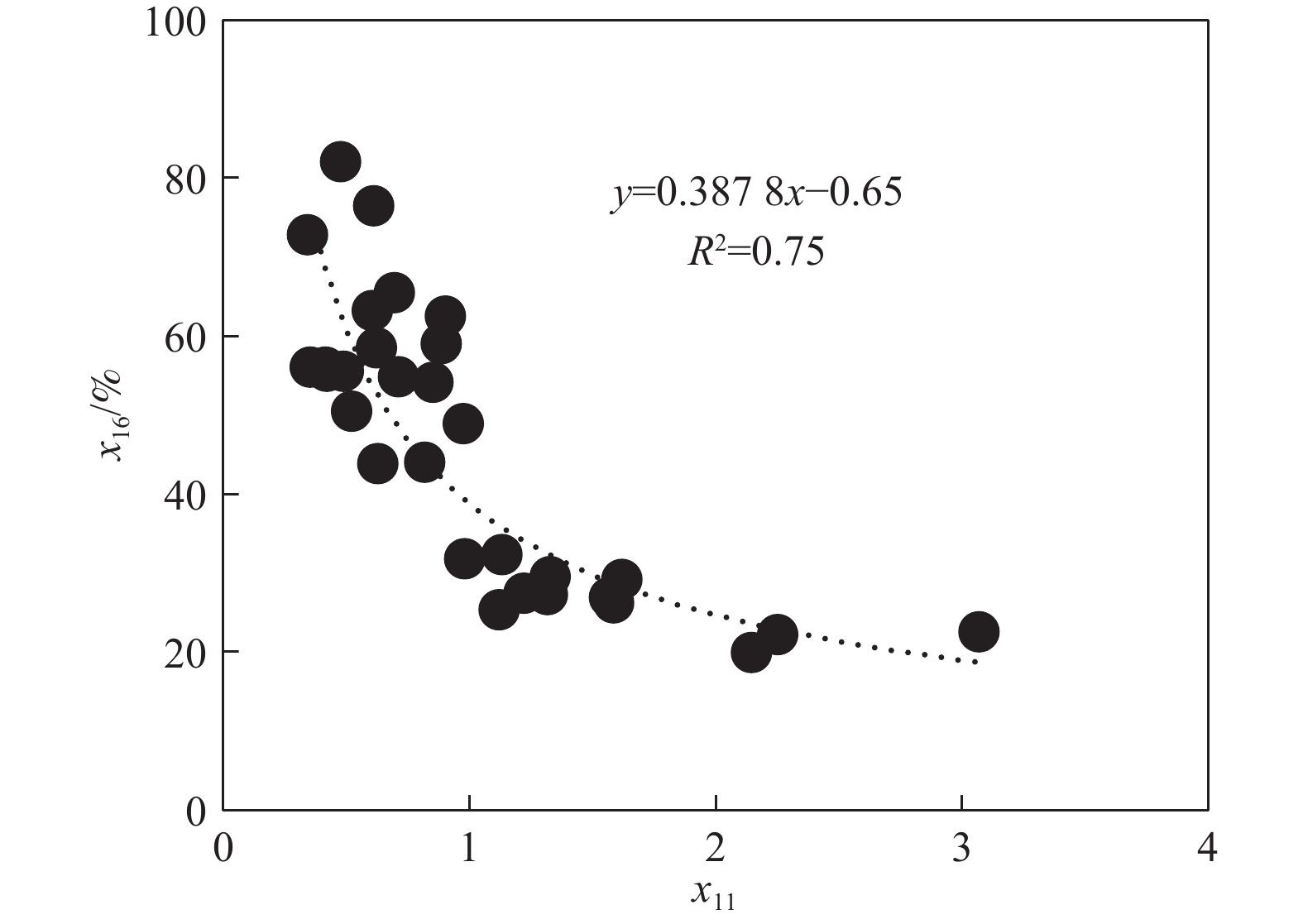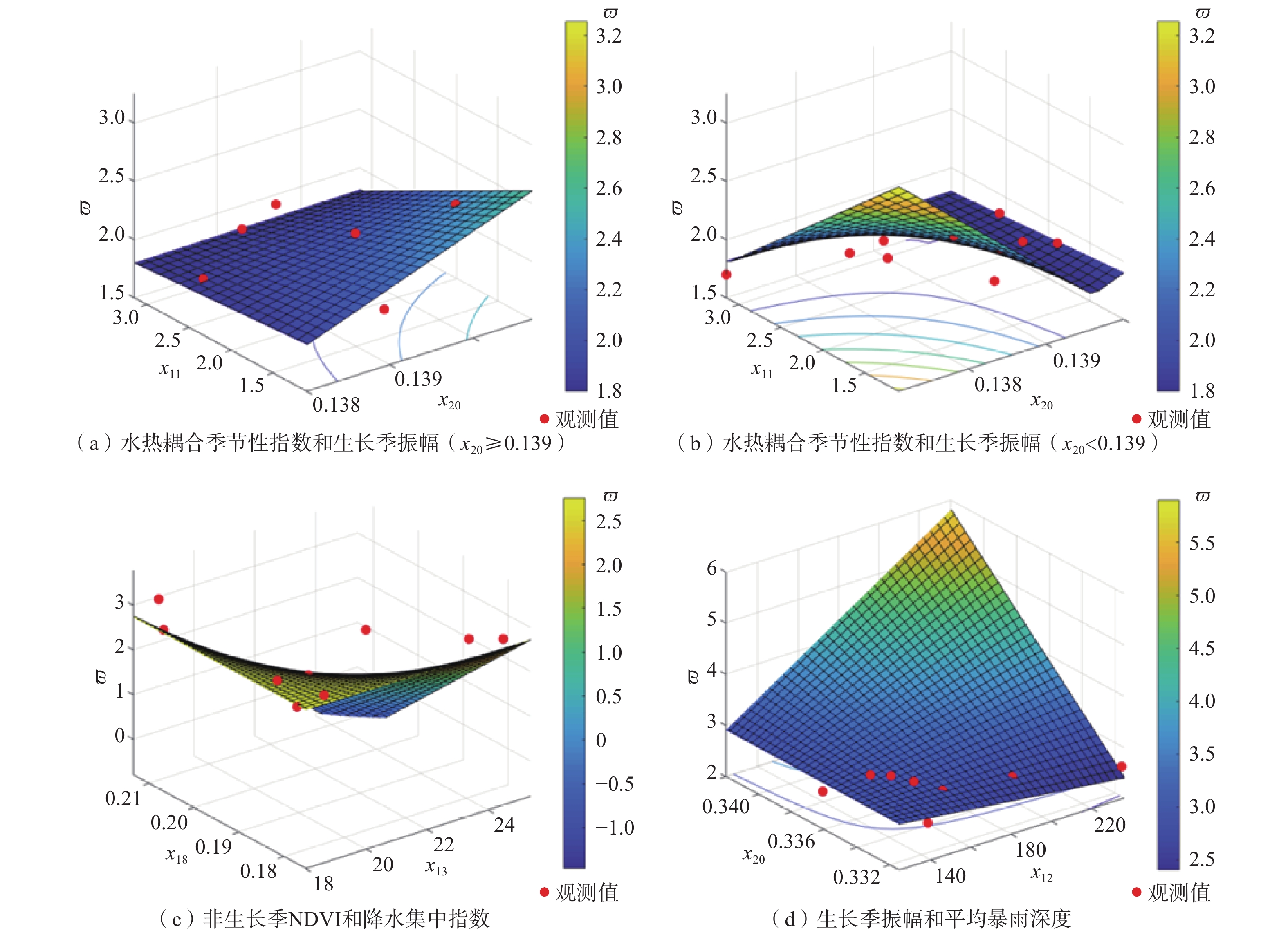A study of influencing factors of spatio-temporal evapotranspiration variation across the Yellow River Basin under the Budyko framework
-
摘要:
蒸散发是水循环过程中的重要环节,研究蒸散发时空变化影响因素,有利于认识区域水资源的时空分异规律。黄河流域地处干旱半干旱地区,水资源短缺且时空分布不均,水问题突出。在黄河流域分析蒸散发对变化环境的响应,揭示气候变化、植被季节性和物候变化的水文水资源效应,对地区水资源可持续发展和规划管理等具有重要的理论意义和现实意义。基于多元自适应回归样条(MARS)非参数模型,采用黄河流域内30个子流域的全球监测与模型研究组(GIMMS)制作的第三代归一化植被指数(NDVI3g)数据集、气象数据、土壤数据、土地利用/覆盖数据以及地形地貌数据,在Budyko框架下分析了水热耦合控制参数ϖ与环境变量因子的关联性,探讨了变化环境对流域蒸散发的影响机制。结果表明:(1)流域水平衡关系的空间变异与流域水热耦合季节性、地形地貌空间变异性、降水的季节性特征(平均暴雨深度和降水变异系数)显著相关。(2)年际尺度上:流域水热的不同步性是影响流域水平衡年际分异最重要的气候季节性指数,水热的不同步性增大,流域的蒸散比减小,产流增加;降水越集中、年内变异程度越高、降水的季节性越明显,流域蒸散比越小;植被的季节性特征是影响流域水平衡的重要因素,植被生长越强,生长季长度越长,流域的蒸散比越大,产流系数越小。(3)环境变量之间存在较强的自相关性,协同演化并作用于流域蒸散发。
Abstract:Evapotranspiration is an important part of water cycle, and the study of evapotranspiration is conducive to understanding the spatio-temporal variation of regional water resources. The Yellow River Basin (YRB) is located in an arid and semi-arid region, and water resources are sparse and uneven in spatio-temporal distribution, and the water issues are prominent. Analyzing the response of evapotranspiration to the changing environment in the YRB and revealing the hydrologic and water resources effects of climate change, vegetation seasonality and phenological variations are of great theoretical and practical significance for the sustainable development and planning and management of regional water resources. Based on the Multivariate Adaptive Regression Splines(MARS) non-parametric model, this paper analyzes the correlation between the water-energy coupling control parameter ϖ and environmental variables under the Budyko framework by using the third generation normalized differential vegetation index datasets(NDVI3g) developed by Global Inventory Modelling and Mapping Studies, meteorological data, soil data, land use/cover data and topographic and geomorphic data of 30 sub-basins in the YRB. The influence mechanism of changing environmental variables on evapotranspiration is discussed. The results show that (1) the spatial variation of the water balance relationship is significantly correlated with the water-energy coupling seasonality, the spatial variability of geomorphology, and the precipitation seasonality (average storm depth and coefficient of variation of precipitation). (2) On the inter-annual scale, a) the water and energy synchronicity is the most important climate seasonality that affects the inter-annual water balance: as water and energy synchronicity increases, the evapotranspiration ratio decreases and runoff yield increases; b) the more concentrated the precipitation, the higher the annual variation and the more obvious the seasonal precipitation, suggesting the smaller the evapotranspiration ratio; c) vegetation seasonality is an important factor affecting the catchment water balance: the stronger the vegetation growth and the longer the growing season, suggesting the larger the evapotranspiration ratio and the smaller the runoff yield coefficient. (3) There is a strong auto-correlation among environmental variables, which co-evolve and act on evapotranspiration.
-

-
表 1 变化环境因子指标体系
Table 1. List of indicators associated with the changed environment
静态变量 动态变量 影响因素 初选表征因子 计算方法 影响因素 初选表征因子 计算方法 地形地貌 高程/m(x1)
相对高程/m(x2)
高程变异(x3)
坡度/(°)(x4)DEM数据
空间统计气候条件 水热耦合季节性指数(x11)
平均暴雨深度/mm(x12)
降水集中指数(x13)
降水变异系数(x14)
降水季节性指数(x15)气象数据[14,18] 土壤条件 相对土壤入渗能力(x5)
植被-土壤相对蓄水能力(x6)土壤性质
气候条件[33]植被条件 植被覆盖度(x16)
年平均NDVI(x17)
非生长季NDVI(x18)
生长季NDVI最大值(x19)
生长季振幅(x20)
生长季合成植被指数(x21)
生长季活跃累积量(x22)
生长季总累积量(x23)植被指数
时间序列[21]土地利用/覆盖结构 林地比例(x7)
灌丛比例(x8)
草地比例(x9)
农田比例(x10)土地利用
空间统计物候信息 相对生长季长度(x24) 表 2 30个子流域的MARS最终模型和精度评价
Table 2. MARS final models and accuracy evaluation for 30 sub-catchments
流域号 水文站 面积/km2 ϖ MARS最终模型及节点 MAE RMSE R2 1# 民和 15342 2.56 0.521×(0.861−x11)+−0.053×(x13-16.9)+−103×(x20-0.452)+ 0.08 0.10 0.65 2# 武山 8080 2.53 0.026×(x12−109)+−95.1×(0.391−x24)+ 0.23 0.30 0.60 3# 靖远 5207 3.55 −2.57×(x14−0.969)+−0.018×(92.9−x12)+ 0.15 0.18 0.65 4# 郭城驿 5470 3.36 −0.282×(x11−0.962)++0.514×(0.962−x11)+−1.96×(x14−1.03)+ 0.22 0.30 0.38 5# 秦安 9805 3.45 −80.4×(0.415−x24)++1.38×(0.653−x11)+ 0.22 0.27 0.62 6# 社棠 1846 3.70 0.019×(140−x12)+−21.5×(x22−3.54)+−13.6×(3.54−x22)+ 0.31 0.39 0.64 7# 千阳 3505 2.86 0.016×(x12−123)+−21.6×(x22−4.57)+−8.92×(4.57−x22)+ 0.45 0.54 0.54 8# 景村 40281 3.25 3.25+0.008×(x12−132)+−0.015×(132−x12)+−2.76×(x14−1.02)+ 0.18 0.22 0.72 9# 张河 1506 2.96 0.017×(x12−135)+−0.565×(x19−0.573)+ 0.28 0.35 0.45 10# 柳林 797 2.05 0.016×(x12−135)++8.11×(0.87−x14)+ 0.49 0.62 0.41 11# 雨落坪 19019 3.35 0.020×(x12−124)+−3.89×(x14−0.982)+ 0.38 0.53 0.51 12# 庆阳 10603 2.84 −0.588×(x11−0.914)++2.2×(0.902−x15)+ 0.19 0.25 0.53 13# 郭家桥 5216 1.80 127×(3.15−  )+×(
)+×( −0.14)++284×(3.15−
−0.14)++284×(3.15− )+×(0.14−
)+×(0.14− )+
)+0.12 0.15 0.70 14# 横山 2415 2.74 −0.191×(x11−0.892)++0.775×(0.892−x11)+−51.5×(0.327−x19)+ 0.15 0.19 0.71 15# 绥德 3893 2.14 0.446×(1.37−x11)++10.7×(x19−0.36)++0.064×(18.4−x13)+ 0.10 0.12 0.83 16# 韩家峁 2452 1.93 0.154×(2.24−x11)++0.004×(x12−93.5)+−0.009×(93.5−x12)++0.89×(1.24−x14)+ 0.07 0.08 0.85 17# 申家湾 1121 2.38 6.81×(x22−1.35)+−0.181×(x11−1.02)+ 0.16 0.21 0.56 18# 神木 7298 2.48 17.5×(x19−0.325)+−46.2×(0.325−x19)+−0.262×(x11−1.04)+ 0.17 0.22 0.65 19# 龙头拐 1145 1.96 99.7×(x18−0.127)++66.3×(0.127−x18)+ 0.19 0.24 0.36 20# 新庙 1527 2.01 5.36×(x23−3.04)+ 0.20 0.25 0.77 21# 上静游 1190 2.59 0.755×(1.02−x11)−0.096(x13−18.7)+ 0.20 0.25 0.48 22# 林家坪 1873 2.76 1.32×(0.792-x11)+−14.7×(  −18)+×(
−18)+×( −0.175)+
−0.175)+0.22 0.26 0.55 23# 高家川 3253 1.64 −0.201×(x11−1.83)++33.7×(x20−0.152)++0.004×(x12−121)+ 0.09 0.11 0.76 24# 后大成 4102 2.19 0.655×(0.966−x11)++38.9×(x24−0.421)+−16.6×(x18−0.219)+ 0.16 0.19 0.59 25# 裴沟 1023 2.59 1.04×(1−x11)+ 0.31 0.39 0.45 26# 大宁 3992 3.07 1.95×(x22−3.52)+−0.371×(x11−0.55)+ 0.19 0.26 0.48 27# 新市河 1662 3.69 0.011×(x12−130)+−0.018×(130-x12)+−3.78×(x14−1.01)+ 0.20 0.24 0.74 28# 大村 2142 3.28 −106×(x20−0.456)+ 0.24 0.32 0.31 29# 吉县 436 2.63 1.11×(0.797−x11)++116×(x24−0.456)++0.006×(x12−119)+ 0.30 0.37 0.62 30# 柴庄 33800 3.09 −5.72×(x15−0.795)++0.019×(x12−124)+−2.87×(  −124)+×(0.342−
−124)+×(0.342− )+
)+0.36 0.50 0.49 注:变量  表示2个相互作用的变量。(xn-a)+指括号内值恒正,如果为负值,则括号内该项为0;其中a为节点值。
表示2个相互作用的变量。(xn-a)+指括号内值恒正,如果为负值,则括号内该项为0;其中a为节点值。 -
[1] FIELD C, BARROS V, STOCKER T, et al. Managing the risks of extreme events and disasters to advance climate change adaptation: A special report of working groups I and II of the intergovernmental panel on climate change[R]. Cambridge University Press, 2012:1-19..
[2] STOCKER T F, QIN D, PLATTNER G K, et al. Climate change 2013: The physical science basis, intergovernmental panel on climate change, working group I contribution to the IPCC fifth assessment report (AR5)[M]. New York: Press CU Editor, 2013.
[3] 刘昌明,张学成. 黄河干流实际来水量不断减少的成因分析[J]. 地理学报,2004,59(3):323 − 330. [LIU Changming,ZHANG Xuecheng. Causal analysis on actual water flow reduction in the mainstream of the Yellow River[J]. Acta Geographica Sinica,2004,59(3):323 − 330. (in Chinese with English abstract) doi: 10.3321/j.issn:0375-5444.2004.03.001
[4] ZHAO Yifei,ZOU Xinqing,ZHANG Jianxiang,et al. Spatio-temporal variation of reference evapotranspiration and aridity index in the Loess Plateau Region of China,during 1961-2012[J]. Quaternary International,2014,349:196 − 206. doi: 10.1016/j.quaint.2014.06.050
[5] GAO Xuerui,SUN Miao,ZHAO Qi,et al. Actual ET modelling based on the Budyko framework and the sustainability of vegetation water use in the loess plateau[J]. Science of the Total Environment,2017,579:1550 − 1559. doi: 10.1016/j.scitotenv.2016.11.163
[6] 王文科. 陆域蒸散发及资源环境效应[J]. 水文地质工程地质,2021,48(3):I − II. [WANG Wenke. Terrestrial evapotranspiration and its effects on resources and environment[J]. Hydrogeology & Engineering Geology,2021,48(3):I − II. (in Chinese with English abstract)
[7] 王周锋,王文科,李俊亭. 蒸散发水源组成与测定方法研究进展[J]. 水文地质工程地质,2021,48(3):1 − 9. [WANG Zhoufeng,WANG Wenke,LI Junting. A review of the advances in water source composition and observation methods of evapotranspiration[J]. Hydrogeology & Engineering Geology,2021,48(3):1 − 9. (in Chinese with English abstract) doi: 10.16030/j.cnki.issn.1000-3665.202012042
[8] WANG Weiguang,ZOU Shan,SHAO Quanxi,et al. The analytical derivation of multiple elasticities of runoff to climate change and catchment characteristics alteration[J]. Journal of Hydrology,2016,541:1042 − 1056. doi: 10.1016/j.jhydrol.2016.08.014
[9] DONOHUE R J,RODERICK M L,MCVICAR T R. Roots,storms and soil pores:Incorporating key ecohydrological processes into Budyko’s hydrological model[J]. Journal of Hydrology,2012,436/437:35 − 50. doi: 10.1016/j.jhydrol.2012.02.033
[10] LI Hongyi,SIVAPALAN M,TIAN Fuqiang,et al. Functional approach to exploring climatic and landscape controls of runoff generation:1. Behavioral constraints on runoff volume[J]. Water Resources Research,2014,50(12):9300 − 9322. doi: 10.1002/2014WR016307
[11] YANG Dawen, SHAO Weiwei, YEH P J F, et al. Impact of vegetation coverage on regional water balance in the nonhumid regions of China[J]. Water Resources Research, 2009, 45(7).
[12] YE Sheng,LI Hongyi,LI Shuai,et al. Vegetation regulation on streamflow intra-annual variability through adaption to climate variations[J]. Geophysical Research Letters,2015,42(23):10307 − 10315.
[13] NING Tingting,LI Zhi,LIU Wenzhao. Vegetation dynamics and climate seasonality jointly control the interannual catchment water balance in the Loess Plateau under the Budyko framework[J]. Hydrology and Earth System Sciences,2017,21(3):1515 − 1526. doi: 10.5194/hess-21-1515-2017
[14] XING Wanqiu,WANG Weiguang,SHAO Quanxi,et al. Identification of dominant interactions between climatic seasonality,catchment characteristics and agricultural activities on Budyko-type equation parameter estimation[J]. Journal of Hydrology,2018,556:585 − 599. doi: 10.1016/j.jhydrol.2017.11.048
[15] FENG Xiaoming,FU Bojie,PIAO Shilong,et al. Revegetation in China’s Loess Plateau is approaching sustainable water resource limits[J]. Nature Climate Change,2016,6(11):1019 − 1022. doi: 10.1038/nclimate3092
[16] LIANG Wei,BAI Dan,WANG Feiyu,et al. Quantifying the impacts of climate change and ecological restoration on streamflow changes based on a Budyko hydrological model in China’s Loess Plateau[J]. Water Resources Research,2015,51(8):6500 − 6519. doi: 10.1002/2014WR016589
[17] WANG Yaqin,LUO Yi,SHAFEEQUE M. Interpretation of vegetation phenology changes using daytime and night-time temperatures across the Yellow River Basin,China[J]. Science of the Total Environment,2019,693:133553. doi: 10.1016/j.scitotenv.2019.07.359
[18] WANG Yaqin,LUO Yi,SHAFEEQUE M. Using a Gaussian function to describe the seasonal courses of monthly precipitation and potential evapotranspiration across the Yellow River Basin,China[J]. Journal of Hydrometeorology,2019,20(11):2185 − 2201. doi: 10.1175/JHM-D-19-0019.1
[19] 王亚琴,孙林,李洪宇等. 黄河流域上中游地区月度 8-km网格气象数据集(1980–2015)[J]. 全球变化数据学报,2022,6(1):25 − 36. [WANG Yaqin,SUN Lin,LI Hongyu,et al. Monthly/8km grid meteorological dataset at the middle and upper reaches of the Yellow River Basin of China (1980–2015)[J]. Journal of Global Change Data & Discovery,2022,6(1):25 − 36. (in Chinese with English abstract)
[20] 吴炳方, 钱金凯, 曾源, 等. 中华人民共和国土地覆被地图集(1∶10 000 000)[M]. 北京: 中国地图出版社, 2017
WU Bingfang, QIAN Jinkai, ZENG Yuan, et al. Land cover atlas of the People’s Republic of China (1∶10 000 000)[M]. Beijing: China Cartographic Publishing House, 2017. (in Chinese)
[21] JONSSON P,EKLUNDH L. Seasonality extraction by function fitting to time-series of satellite sensor data[J]. IEEE Transactions on Geoscience and Remote Sensing,2002,40(8):1824 − 1832. doi: 10.1109/TGRS.2002.802519
[22] BUDYKO M I, MILLER EEEB D H. Climate and life [M]. New York: Academic, 1974.
[23] 傅抱璞. 论陆面蒸发的计算[J]. 大气科学,1981,5(1):23 − 31. [FU Baopu. On the calculation of the evaporation from land surface[J]. Scientia Atmospheric Sinica,1981,5(1):23 − 31. (in Chinese with English abstract) doi: 10.3878/j.issn.1006-9895.1981.01.03
[24] DU C,SUN F,YU Jingjie,et al. New interpretation of the role of water balance in an extended Budyko hypothesis in arid regions[J]. Hydrology and Earth System Sciences,2015,20:393 − 409.
[25] ALLEN R G, PEREIRA L S, RAES D, et al. Crop evapotranspiration: Guidelines for computing crop water requirements[C]//Irrigation and Drainage Paper 56. Food and Agriculture, Organization. Rome, 1998: 56.
[26] 李云凤,王文科,王国庆,等. 黄河源区潜在蒸散量估算方法适用性分析[J]. 水文地质工程地质,2021,48(3):10 − 19. [LI Yunfeng,WANG Wenke,WANG Guoqing,et al. The applicability of various potential evapotranspiration estimation methods in the headwater area of the Yellow River[J]. Hydrogeology & Engineering Geology,2021,48(3):10 − 19. (in Chinese with English abstract) doi: 10.16030/j.cnki.issn.1000-3665.202011044
[27] 阴晓伟,吴一平,赵文智,等. 西北旱区潜在蒸散发的气候敏感性及其干旱特征研究[J]. 水文地质工程地质,2021,48(3):20 − 30. [YIN Xiaowei,WU Yiping,ZHAO Wenzhi,et al. Drought characteristics and sensitivity of potential evapotranspiration to climatic factors in the arid and semi-arid areas of northwest China[J]. Hydrogeology & Engineering Geology,2021,48(3):20 − 30. (in Chinese with English abstract) doi: 10.16030/j.cnki.issn.1000-3665.202012012
[28] ZHANG L,DAWES W R,WALKER G R. Response of mean annual evapotranspiration to vegetation changes at catchment scale[J]. Water Resources Research,2001,37(3):701 − 708. doi: 10.1029/2000WR900325
[29] ABATZOGLOU J T,FICKLIN D L. Climatic and physiographic controls of spatial variability in surface water balance over the contiguous United States using the Budyko relationship[J]. Water Resources Research,2017,53(9):7630 − 7643. doi: 10.1002/2017WR020843
[30] MILLY P C D. Climate,interseasonal storage of soil water,and the annual water balance[J]. Advances in Water Resources,1994,17(1/2):19 − 24.
[31] SHAO Quanxi, TRAYLEN A, ZHANG Lu. Nonparametric method for estimating the effects of climatic and catchment characteristics on mean annual evapotranspiration[J]. Water Resources Research, 2012, 48(3): W03517.
[32] DE LAVENNE A,ANDRÉASSIAN V. Impact of climate seasonality on catchment yield:A parameterization for commonly-used water balance formulas[J]. Journal of Hydrology,2018,558:266 − 274. doi: 10.1016/j.jhydrol.2018.01.009
[33] 孙福宝. 基于Budyko水热耦合平衡假设的流域蒸散发研究[D]. 北京: 清华大学, 2007
SUN Fubao. Study on watershed evapotranspiration based on the budyko hypothesis[D]. Beijing: Tsinghua University, 2007. (in Chinese with English abstract)
[34] FRIEDMAN D. Evolutionary games in economics[J]. Econometrica,1991,59(3):637. doi: 10.2307/2938222
[35] EAGLESON P S. Ecohydrology: Darwinian expression of vegetation form and function[M]. Cambridge: Cambridge University Press, 2002
[36] FU Jianyu,WANG Weiguang. On the lower bound of Budyko curve:the influence of precipitation seasonality[J]. Journal of Hydrology,2019,570:292 − 303. doi: 10.1016/j.jhydrol.2018.12.062
-




 下载:
下载:



